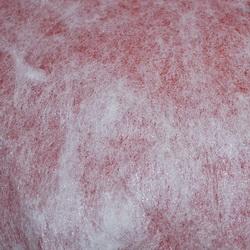Search the Community
Showing results for tags 'stabilizers'.
-
Original text by Marina Belova Proper stabilization of the fabric during the embroidery in order to prevent the distortion remains one of the most acute problems. Even in my not so long embroidery career, numerous garments were ruined simply because of disinclination or, more often, inability to use the stabilizers (or interfacing materials). It goes without saying that, unfortunately, I don't always use them even now. The rules of choosing a stabilizer (or interfacing) are very simple and quite logical. It only takes to comprehend them once in order to use a suitable kind of stabilizer in any particular case in future. In my opinion, all stabilizers should be divided into two main categories: Backings Toppings Below I'll only list the types of stabilizers commonly used. Backings Backings are special materials, usually non-woven, which are placed under the fabric. They serve to support and stabilize the fabric when it's being embroidered, prevent creasing, distortion, stretch and pull, both during the embroidery and after washing or dry-cleaning. There are several types of backings: Tear-away Cut-away Adhesive Soluble Fusible Tear-away stabilizers This type of stabilizers is good for most fabrics made of natural fibers and gives only a temporary support. Main recommendations: this type of backing is easily removed and can be successfully used with the items where the wrong side can be seen (towels, plaids, scarfs and so on). It is also widely used with non-transparent fabrics of fair colors, with thick and densely woven fabrics made of natural fibers — like denim. Not recommended for knits. Tear-away stabilizers are usually made of paper. And their thickness may vary. Cut-away stabilizers Cut-away backings are used when it is necessary to hold a highly stretchy fabric in place during the embroidery and stabilize it properly. They are necessary to embroider a design with a lot of stitches, in order to avoid gathering of the fabric, preventing the appear of bulges or concavities even after several washes. A cut-away stabilizer is always thicker than a tear-away one. Usually, this is a non-woven fabric made of long fibers on the basis of polyester or rayon. The distribution of the fibers in the backing is also of huge importance. If the fibers are mainly single-oriented, it stretches in tears in this one direction. Therefore, to stabilize the fabric properly you need to use 2 layers of backing, positioning them perpendicularly. Such backings are of varying density. If the fibers in the non-woven material run in multiple directions, it has an uneven grainy structure with knots here and there. This unevenness can make the fabric less stable. But this kind of material is good for the embroidery nevertheless and is used often because it's cheap. This kind of stabilizer can also be of varying density. Bonding short fibers (polyester, rayon, cellulose) together by solvent treatment, you'll get a non-woven fabric of high quality, which is soft like a tear-away stabilizer, has a smooth surface and does not stretch in any direction. This stabilizer can be of varying density and just 1 layer of it is sufficient. It is considered most optimal for stabilizing because it does not add extra volume to the embroidery and is invisible through the fabric. Recommendations: to add stability to this kind of backing you can spray it with temporary spray adhesive. Among the cut-away stabilizers spunbond stands out — thin, very soft material that resembles a waffle. There are stabilizers produced in the USA that are called Poly Mesh or No Show Mesh. This kind of backing is good because it does not stretch at all, providing support all the time and is not visible through the fabric. It comes in various colors and densities. This kind of stabilizer is good for embroidery on knitwear. Adhesive stabilizers They allow the item to be stuck onto them, thus stabilizing the fabric. There are several types of them: Ordinary stabilizer with glue on one side. The item is stuck onto such backing with an iron. Adhesive paper with glue on one side that is covered with a protective layer. This paper is necessary when embroidering tricky fabrics: velvet, cashmere, leather, which are not recommended for hooping. And also for the items that are hard to hoop: collars, cuffs, small details. The paper is placed in the hoop with the sticky side up, then the protective layer is removed and the item is placed on top. Afterward, you simply tear the paper away from the item. Solvent stabilizers Solvent stabilizers include a water-soluble stabilizer that is very much like fabric and water-soluble film of varying density. They are used for stabilizing the embroidery when it is necessary to remove the backing for good so that it was not at all visible. For example, organza, transparent fabrics, FSL and also cutwork. Read more on using this kind of stabilizer here. Fusible stabilizers They are used when it is necessary to stabilize the fabric, which cannot be made wet, but the backing leftovers need to be removed. They can be successfully used for embroidering FSL, as well as water-soluble film. They are usually removed with a very hot iron (no less than 120°) or with the pressing machine through the ordinary paper. Under no circumstances should steam be used with fusible stabilizers. Toppings Toppings are special materials that are placed on top of the fabric. They are necessary to prevent the stitches from sinking into the pile, loops, fur and other such materials, also in loosely-woven fabrics like knits. Gelatin-based toppings are used most often because they can be easily solved in water. We call them wash-away toppings or water soluble toppings (film). There are two main kinds of water-soluble toppings: thin and thick (dense) ones. The thin film is used practically with everything, and thick ones only with high piles. The other type of toppings are fusible toppings (we call them heat-away, fusible or heat-soluble). They are used in cases when the fabric cannot be washed, and therefore, the water-soluble film cannot be used. They are usually removed with a very hot iron (no less than 120°) or with the pressing machine through the ordinary paper. Under any circumstances don't use steam with fusible stabilizers. Main rules of using the stabilizers The thicker is the fabric, the heavier the backing should be, and vice versa, the thinner the fabric, the less dense the backing. The more stitches are in the design, the denser the design itself should be, and the thicker the backing should be for stabilizing the fabric. When embroidering with metallic threads you should avoid synthetic backings and try to use the ones made of natural fibers (cotton or rayon), like Madeira E-ZEE Cotton Soft. This is necessary because stabilizers made of natural fibers are softer, they create less friction to the thread and needles, so the needle does not overheat and the thread breaks less often. How does one decide which stabilizer to use? Every time you need to answer these questions: the stability of the fabric, the density of the design, stitch lengths, embroidery speed, thread type. All of these parameters determine what your choice will be. Also, you can read my article on matching the fabric with the stabilizer. In the course of time, I singled out the stabilizers that I use the most. I've covered them at length in this blog.
-
I got Brothers SE 400 and struggling to learn for embroidery. I read lot of them online. I am new to this forum and would like to ask you all about better stabilizers for children's t-shirts. I heard about light, medium and heavy weight. Are they awesome to use? Please let me know.
- 5 replies
-
- stabilizer
- stabilizers
-
(and 3 more)
Tagged with:
-
I have a friend who is a beginner stitcher as I am, but she insist that you do not need to stabilize quilted fabric. I told her you do need it so the design doesn't shift. She doesn't want to waste time attaching stabilizer by ironing on or sticky stabilizer. I think she is just lazy and don't really care how the backside looks after stitching. Can you answer this question for me. I sometime double when stitching lighter weight fabric such as knits and t-shirt fabric.
- 10 replies
-
- stabilizer
- stabilizers
-
(and 3 more)
Tagged with:




